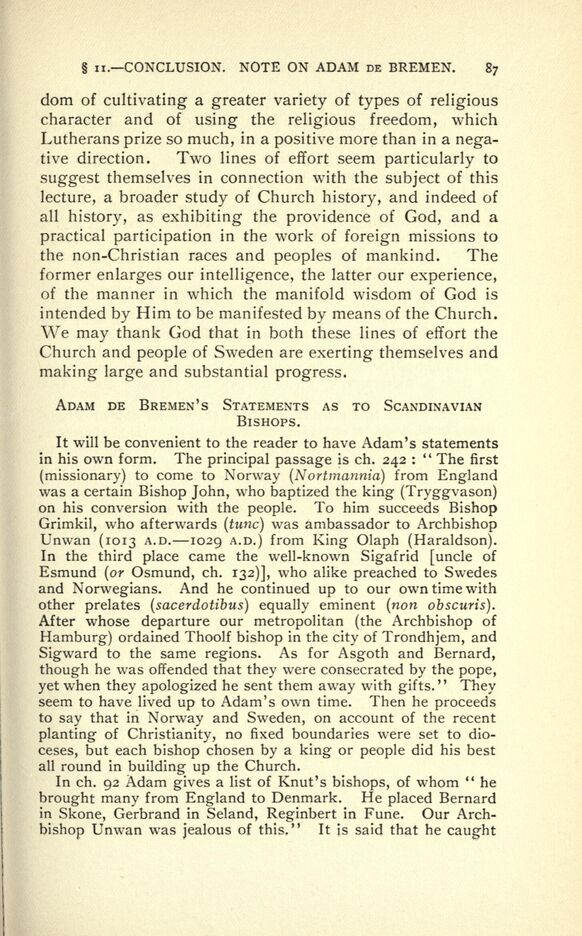
Full resolution (JPEG) - On this page / på denna sida - II. The Conversion of Sweden (830—1130 A.D.) - Adam de Bremen’s Statements as to Scandinavian Bishops

<< prev. page << föreg. sida << >> nästa sida >> next page >>
Below is the raw OCR text
from the above scanned image.
Do you see an error? Proofread the page now!
Här nedan syns maskintolkade texten från faksimilbilden ovan.
Ser du något fel? Korrekturläs sidan nu!
This page has never been proofread. / Denna sida har aldrig korrekturlästs.
ii. CONCLUSION. NOTE ON ADAM DE BREMEN. 87
dom of cultivating a greater variety of types of religious
character and of using the religious freedom, which
Lutherans prize so much, in a positive more than in a nega
tive direction. Two lines of effort seem particularly to
suggest themselves in connection with the subject of this
lecture, a broader study of Church history, and indeed of
all history, as exhibiting the providence of God, and a
practical participation in the work of foreign missions to
the non-Christian races and peoples of mankind. The
former enlarges our intelligence, the latter our experience,
of the manner in which the manifold wisdom of God is
intended by Him to be manifested by means of the Church.
We may thank God that in both these lines of effort the
Church and people of Swr
eden are exerting themselves and
making large and substantial progress.
ADAM DE BREMEN S STATEMENTS AS TO SCANDINAVIAN
BISHOPS.
It will be convenient to the reader to have Adam s statements
in his own form. The principal passage is ch. 242 :
"
The first
(missionary) to come to Norway (Nortmannia) from England
was a certain Bishop John, who baptized the king (Tryggvason)
on his conversion with the people. To him succeeds Bishop
Grimkil, who afterwards (tune) was ambassador to Archbishop
Unwan (1013 A.D. 1029 A.D.) from King Olaph (Haraldson).
In the third place came the well-known Sigafrid [uncle of
Esmund (or Osmund, ch. 132)], who alike preached to Swedes
and Norwegians. And he continued up to our own time with
other prelates (sacerdotibus) equally eminent (non obscuris).
After whose departure our metropolitan (the Archbishop of
Hamburg) ordained Thoolf bishop in the city of Trondhjem, and
Sigward to the same regions. As for Asgoth and Bernard,
though he was offended that they were consecrated by the pope,
yet when they apologized he sent them away with gifts. They
seem to have lived up to Adam s own time. Then he proceeds
to say that in Norway and Sweden, on account of the recent
planting of Christianity, no fixed boundaries were set to dio
ceses, but each bishop chosen by a king or people did his best
all round in building up the Church.
In ch. 92 Adam gives a list of Knut s bishops, of whom "
he
brought many from England to Denmark. He placed Bernard
in Skone, Gerbrand in Seland, Reginbert in Fune. Our Arch
bishop Unwan was jealous of this." It is said that he caught
<< prev. page << föreg. sida << >> nästa sida >> next page >>